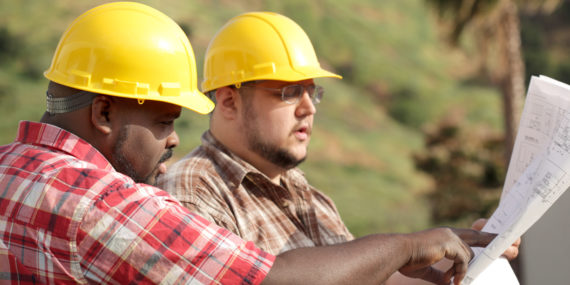In “A Foreman’s Approach to Working with New Employees: Week 1,” we shared many efforts that the Crew Foreman needs to take to ensure that the new employee’s first week is filled with getting a good feeling about the nature of work completed, some of the basic tools and processes, and getting a feel for the members on the crew. Impressions made on the first day are either confirmed or adjusted through the remaining first week.
Now, if the new employee is still with you to begin their second week, the remaining three weeks will present the new employee with a series of “firsts.” The “firsts” will focus more on learning the correct technique to use when handling a tool or when to provide needed support or input to another worker.
 It’s not too hard to think and see that during the new employee’s first month, many first steps will be emphasized and instructed, laying down a strong foundation of safe and proper techniques to complete work.
It’s not too hard to think and see that during the new employee’s first month, many first steps will be emphasized and instructed, laying down a strong foundation of safe and proper techniques to complete work.
As the Foreman continues to work with the new employee, it will be important for them to continue emphasizing many of the following efforts. Remember, this new worker is still new to the company, the crew, and many will be new to construction. Therefore, it is vital that the Foreman continue the new employee’s learning experience but in a way that is also enjoyable and confidence building. Here in lies perhaps the bigger challenge, making the work fulfilling to his new worker.
- Start Each New Work Day with the Day’s Goals & Expectations (Crew Huddle)
Foremen should always begin each day presenting what the day’s goals are and any expectations needing additional attention. But providing such information with one or more new workers on the crew can provide additional help to giving the new workers the “big picture” for the day. It’s sort of like explaining the “Why” to the reason they will be executing the needed work. This short meeting, at the job site, is often called a Crew Huddle. Other topics may be addressed during this morning meeting including safety, addressing any needs or questions of the workers, any change in work order or procedure, etc.
- Take 2-Minutes to Provide Extra Training for New Employee’s Work Tasks
It’s important to overdo the amount of training you provide your new worker. The sooner a new worker feels comfortable and confident in performing a task, their level of enjoyment will actually be enhanced. This may sound like a non-important aspect to training but the more enjoyable performing a task is to any employee, the more they want to repeat the experience. Most research also confirms that what people learn and enjoy, the greater their satisfaction is with work and the less likely they will be considering other work opportunities.
- Expose the New Worker to More than One Skill Building Task
It’s fairly common that a new worker is given a few “grunt” tasks during their early time with a contractor. Some of these grunt tasks can include things like carrying materials and tools to other workers, doing more than their share of cleaning up the work site, and running out to grab lunch or water for other workers. While there may be some of this that is acceptable, it is more productive to engage the new worker with some legitimate work tasks. For most trades there are always a number of tasks that provide a beginning to greater and more difficult progression of skills. A quick example is for a concrete finisher to first learn how to “strike off” concrete. Training the new worker on the proper method to strike off the concrete, instructing them on why and how much, will make the new worker more valuable to the rest of the crew as they prepare to finish a deck, foundation, or sidewalk.
For the new worker learning to paint commercial projects, it might begin with the need to tape off edges so that the paint job provides a nice clean and straight line when the tape is removed. For the asphalt paver, it could include teaching the new worker the importance of and how to “tack” the edges of their paving effort to the hot asphalt material will bond.
The primary reason for exposing your new worker to more than one task is that you, and the worker, need to get a feel for what the new worker might have a more natural affinity to do. Some workers take to a job task or technique as quickly as a duck takes to water. Remember, an important intention for the Foreman is to assess the new worker to determine what potential they have that can be further developed . Finding the areas that the new worker can begin to feel comfortable with performing will only add to their encouragement and importance to the crew.
- Maintain a Regular (Weekly) Review of the New Workers’ Work Experience
We introduced asking the new worker what they were learning during the first week, that pattern needs to be continued for the first month. In fact, while the Foreman needs to maintain discussing with the new worker their frustrations and questions, it is also helpful to have the senior leaders to the Foreman to participate in this effort as well. Being intentional about checking up on the new worker multiple times reinforces your company’s interest in keeping the new worker; we normally don’t show much attention to someone if we’re not interested in keeping a new worker.
- Shadow the New Employee with an Experienced Worker to Drive Skill Development
With less than thirty-days of service, the new worker is far from being a “slam dunk” to becoming the best employee. It may be the Foreman who takes on the new worker personally, who works to develop the new worker’s skills and gaining a richer familiarity with the company, work processes, and tools and equipment but if it’s not, then the Foreman should have one of the better workers shadow the new worker. Such shadowing will again provide some added insurance to keeping the worker safe, teaching them the right way to do things, and continue to add to the confidence of the new worker that the company wants them to be successful.
- Ask the New Employee to Train You on a Newly Learned Task or Technique
This is an effort that will continue over the first ninety-days but it is a great act for the Foreman to initiate with their new worker during the first thirty-days. This process should be approached in a more light-hearted way but one that allows the Foreman to hear, in the new worker’s words, how to complete a task. This provides the Foreman with a few benefits including confirming that the new worker is retaining instruction, that they are always considering the safety aspects of the task, and the reasons behind why the task is performed in the first place. The first time this effort takes place will cause the new worker to be a little nervous but the Foreman can lessen the nervousness by almost feeding the new worker a few lines or words to help them along.
We will expand on this sixth action in our fourth article but it’s important to see its use here in the first thirty-days. It just is a great way to add to the new workers’ confidence and further confirm that the Foreman, and the company, want them to be successful and to remain a part of the crew.
- Don’t Forget to Have Some Fun & to Ask the New Worker… “How you doing?”
Construction is supposed to be fun. In fact, construction is perhaps the best industry in the world. Shouldn’t we act like it is? While what we do in construction is serious, we can still have a good time taking pride in doing things right, the first time. We can still have a good time working in a team-like fashion with other workers of different backgrounds and experiences. We can still see the funny side to work and life, enjoying some of the funniest personalities in the world.
It’s important for you, the Foreman, to not only look like you enjoy construction, but to actually enjoy the work yourself. Even when it’s the hottest or coldest temperatures outside, or even when a few workers didn’t show up to work, or when another contractor has forced you into making some significant work changes for the day, you need to model the excellence of not letting anything get you unraveled.
Periodically, you should ask an honest and straight-forward question of your new worker, “Hey Jackie, how you doing?” Asking the new worker how they are feeling about work, how their family is doing, how they are holding up with the learning, all of these add on questions can reassure the new worker that you, their Foreman, is taking a personal interest in them, their success, and their future with your company.
Well, we now have taken a new worker through their first thirty-days. We’re a long way from having them fully integrated and trained, but we have gotten off to a great start. Couple of things to keep in mind:
- As the new employee is approaching thirty-days of working for you, the newness of the company, the crew members, and even some of the work tasks, are beginning to just feel normal to the worker.
- Early in any worker’s career, finding anything that they can do and perform with some level of confidence and even a bit of accuracy, can sustain the worker’s interest in construction and to working for you and your company.
- The 30-Day mark is not final but it is significant in the development process for a new worker. Some research has indicated that if we can keep a new worker a week, we can keep them a month. And, if we can keep them a month, we have a greater chance to keep them for 90-Days.
In our next article, we will look at things a Foreman can do during the first 90-Days of a new employee, actions to strengthen the new employee’s skills and behavior as well as strengthen the company’s belief that they have found a good worker for years to come.
Take the insights shared in this look at the first thirty-days and continue to impact your new workers, inciting them to see you, your crew, and your company as the experience they want to continue.
Brad Humphrey
The Contractor’s Best Friend ™

